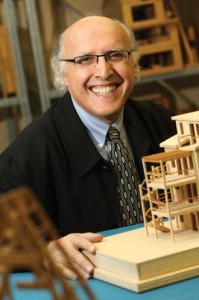
By Neale McDevitt
If Avi Friedman were designing the Ivory Tower, he’d make it only one floor but with the possibility of easy expansion. He’d also do away with expensive ivory and use affordable, pre-fab materials that were snapped into place without a fuss. Finally, rather than the mythical metaphysical space of solitude and sanctity disconnected from daily realities, he’d make sure the tower had easy access to the community from all directions.
Friedman, a professor in the School of Architecture, has been on a 20-year mission as an advocate for and the architect of affordable homes for all.
“In 1990, Canada woke up to the realization that housing wasn’t as affordable as it used to be,” said Friedman.
To address these issues, Friedman established the Affordable Homes Program, which he saw as “a wonderful opportunity to start with a clean slate and put the home under a microscope.”
The project moved from the drafting table to the construction site later that year, when Friedman built the prototype Grow Home on the McGill Campus. Smaller than conventional houses, the house was designed for increasingly smaller families and first-time homeowners.
But, asked critics, who wanted a house that was 14-feet wide?
A lot of people apparently. Twenty-four units were bought the first weekend they went on the market and the first development of 89 units sold out in two weeks. As Friedman’s design made headlines in the New York Times and L.A. Times, more than one thousand units were built across North America and Europe in the first year alone.
In 1998, Friedman took a sabbatical in Guadalajara, Mexico where he was stunned by the living conditions of the poor.
In typical Friedman fashion, he charged back home, secured grants from the provincial and federal governments, designed a small prototype home, loaded a 40-foot truck with materials and drove down to Mexico. With city planners and local builders as interested onlookers, Friedman and his crew built a house in three days. Officials were impressed and Friedman’s Casa a la Carta initiative took off. “We didn’t just design a house,” said Friedman, “we wanted to help the poor of the world by introducing a paradigm, a model and a new way of thinking about how to address issues of poverty.”
Back in Canada, Friedman’s expertise has been in constant demand. He and his students have helped with dozens of urban renewal projects, flying into cities like Lethbridge, Ab.; Regina, Sask; and Fredericton, N.B.; to help redesign, renew and, in many cases, resuscitate dilapidated neighborhoods, waterfronts and downtown cores – always keeping in mind issues of sustainability and affordability.
When asked why he does so much above and beyond his required duties as a professor, Friedman smiles. “I believe if you see yourself only as an academic and surround yourself with academic boundaries then you’re not tapping into your true potential,” he said. “But if you are able to walk the mile and be an agent of change – that’s when you’re being of greatest service to your country and the world.”
